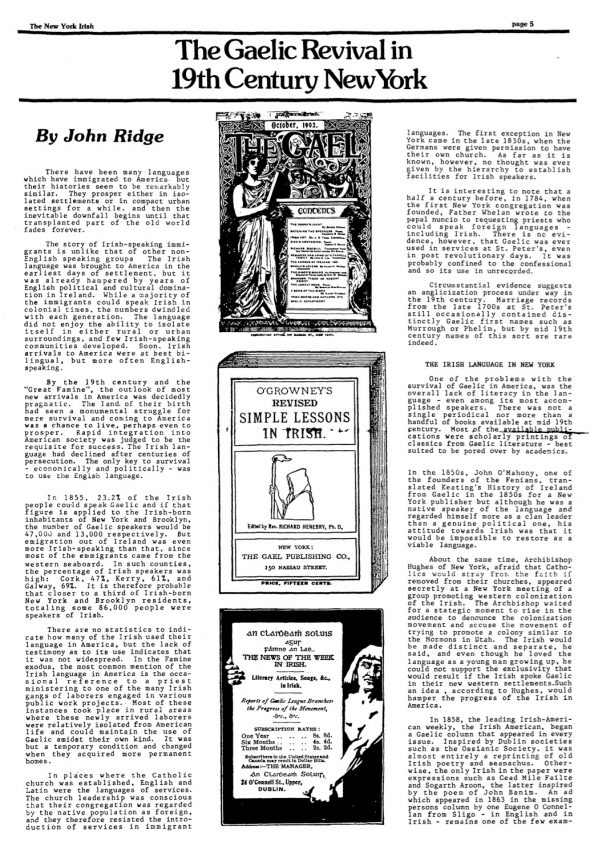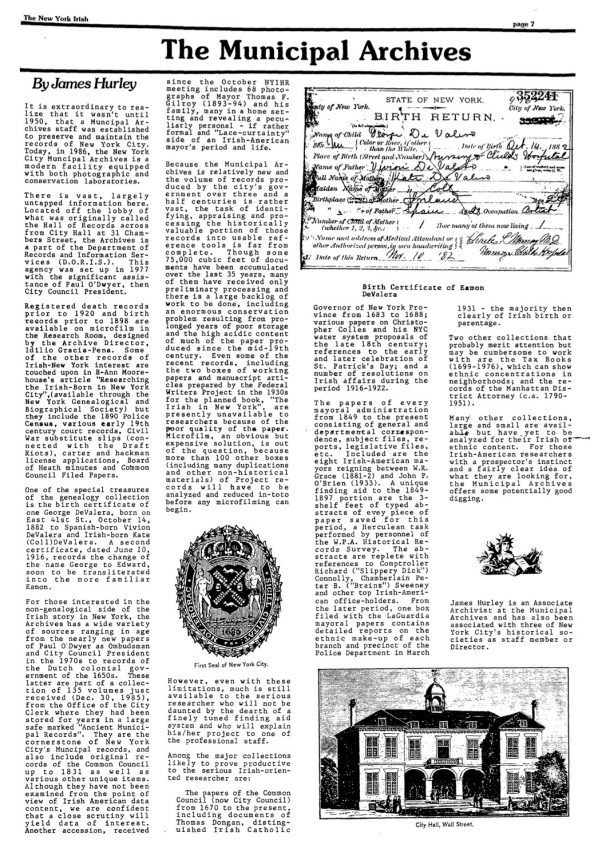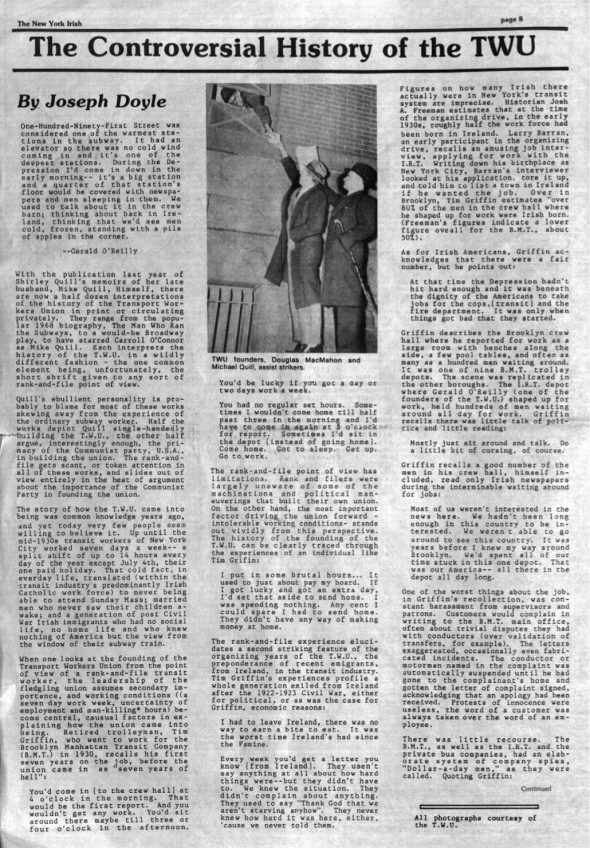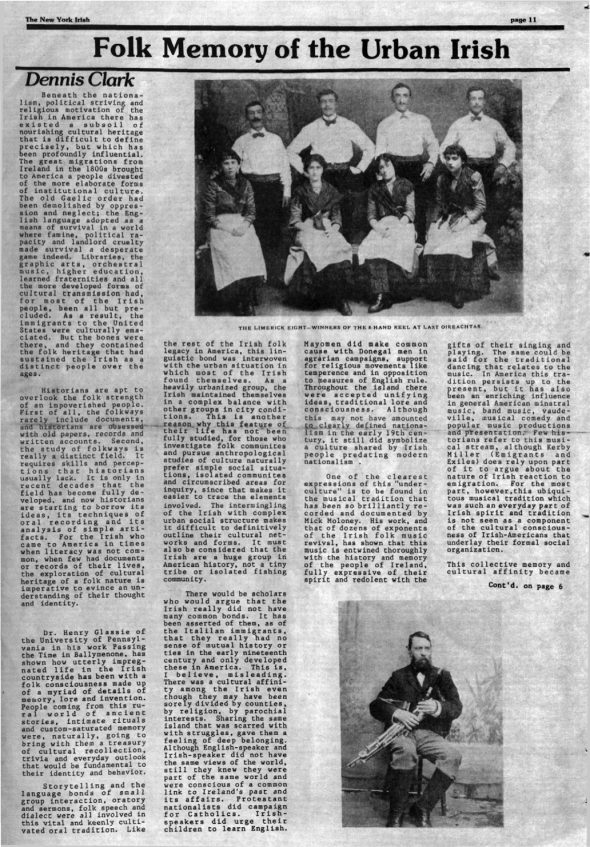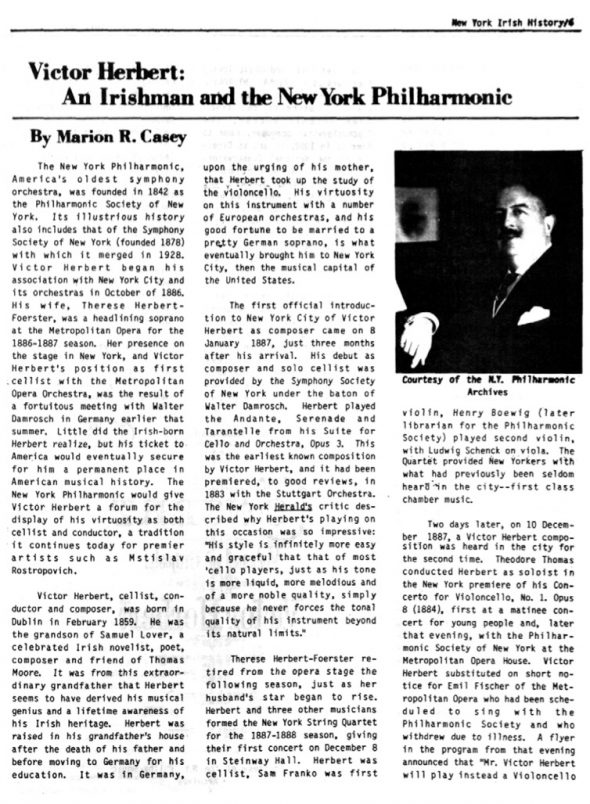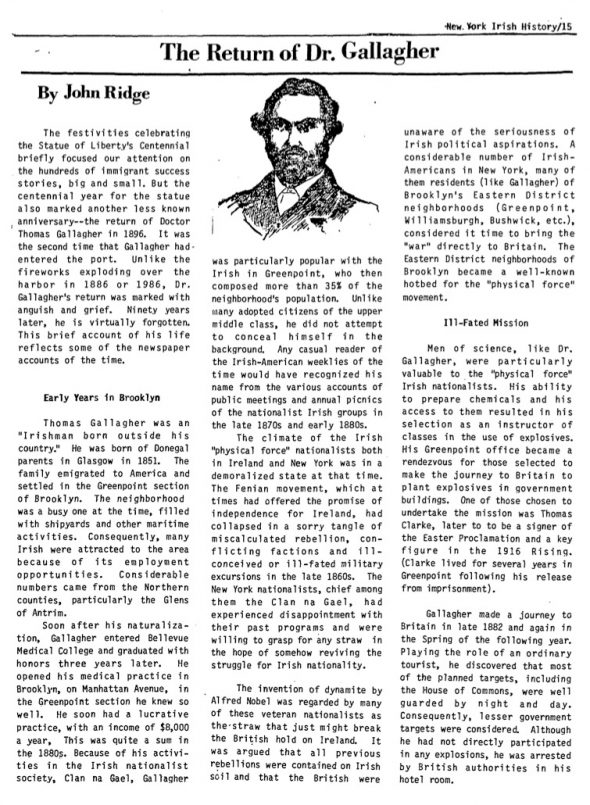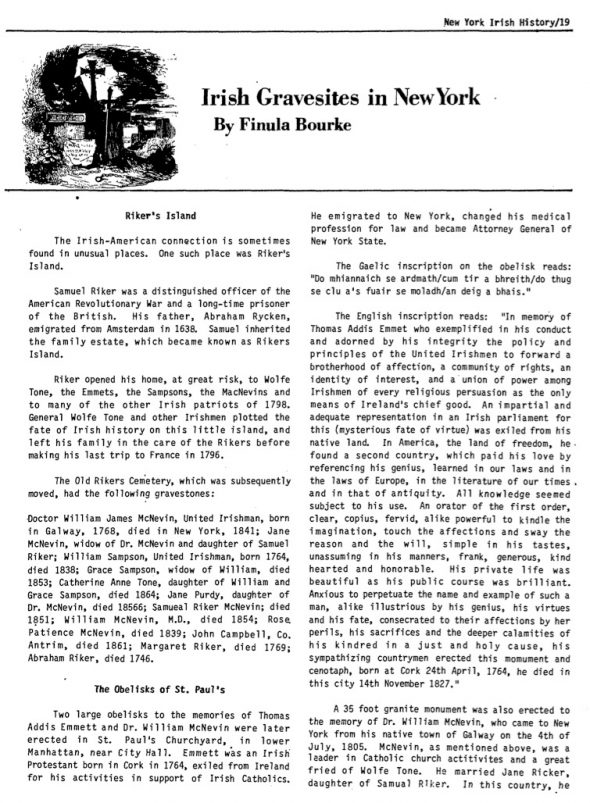New York Irish History Roundtable - Journal Articles
The Last Mayor Of Long Island City - Patrick Jerome Gleason
Author: Joseph Brunelle
Publication Year: 1986
Journal Volume: 01
Article Reference: NYIHR-V01-01
November 2, 1886 marks the 100th anniversary of the election of Patrick Jerome Gleason as mayor of Long Island City (LIC), New York. Between its incorporation as a city in 1870, and its final absorption into Greater New York City in 1898, LIC encompassed the areas of Western Queens now identified as Hunters Point, Ravenswood, Astoria, Sunnyside and part of Woodside. From 1881, when he was first elected to the LIC Board of Aldermen, to 1898 when helost the mayor's job in the Greater NYC incorporation, Gleason dominated the political life of... [Read Full Article]
The Gaelic Revival in 19th Century New York
Author: John Ridge
Publication Year: 1986
Journal Volume: 01
Article Reference: NYIHR-V01-02
There have been many languages which have immigrated to America, but their histories seem to be remarkably similar. They prosper either in isolated settlements or in compact urban settings for a while, and then the inevitable downfall begins until that transplanted part of the old world fades forever.
The story of Irish-speaking immigrants is unlike that of other non-English speaking groups The Irish language was brought to America in the earliest days of settlement, but it was already hampered by years of English political and... [Read Full Article]
The Municipal Archives
Author: James Hurley
Publication Year: 1986
Journal Volume: 01
Article Reference: NYIHR-V01-03
It is extraordinary to realize that it wasn't until 1950, that a Muncipal Archives staff was established to preserve and maintain the records of New York City. Today, in 1986, the New York City Muncipal Archives is a modern facility equipped with both photographic and conservation laboratories. There is vast, largely untapped information here.
Located off the lobby of what was originally called the Hall of Records across from City Hall at 31 Chambers Street, the Archives is a part of the Department of Records and Information Services... [Read Full Article]
The Controversial History of the TWU
Author: Joseph Doyle
Publication Year: 1986
Journal Volume: 01
Article Reference: NYIHR-V01-04
One-Hundred-Ninety-First Street was considered one of the warmest stations in the subway. It had an elevator so there was no cold wind coming in and it's one of the deepest stations. During the Depression I'd come in down in the early morning-- it's a big station and a quarter of that station's floor would be covered with newspapers and men sleeping in them. We used to talk about it in the crew barn; thinking about back in Ireland, thinking that we'd see men cold, frozen, standing with a pile of apples in the corner.... [Read Full Article]
Folk Memory Of The Urban Irish
Author: Dennis Clark
Publication Year: 1986
Journal Volume: 01
Article Reference: NYIHR-V01-05
Beneath the nationalism, political striving and religious motivation of the Irish in America there has existed a subsoil of nourishing cultural heritage that is difficult to define precisely, but which has been profoundly influential.
The great migrations from Ireland in the 1800s brought to America a people divested of the more elaborate forms of institutional culture.
The old Gaelic order had been demolished by oppression and neglect; the English language adopted as a means of survival in a world where famine, political... [Read Full Article]
Victor Herbert - An Irishman and the New York Philharmonic
Author: Marion R. Casey
Publication Year: 1987
Journal Volume: 02
Article Reference: NYIHR-V02-01
The New York Philharmonic, America's oldest symphony orchestra, was founded in 1842 as the Philharmonic Society of New York. Its Illustrious history also includes that of the Symphony Society of New York (founded 1878) with which it merged in 1928. Victor Herbert began his association with New York City and Its orchestras in October of 1886. His wife, Therese Herbert-Foerster, was a headlining soprano at the Metropolitan Opera for the 1886-1887 season. Her presence on the stage in New York, and Victor Herbert's position as first cellist... [Read Full Article]
Counting Board, Altar and Vista - The Bradys and Inisfada
Author: Richard Harmond
Publication Year: 1987
Journal Volume: 02
Article Reference: NYIHR-V02-02
It was uncommon for an Irish Catholic to be welcomed into the highest economic and social circles before the 1920s. In the usual scenario, it would take several generations for such a family to gain admittance to the American upper class. Yet Nicholas Brady, a businessman and financier, who was the son of an immigrant father, attained entree to those circles well before World War I. In terms of economic influence, Brady may well have been the single most powerful Irish Catholic in the United .States during the 1920s. When he died in 1930,... [Read Full Article]
The Return of Dr. Gallagher
Author: John Ridge
Publication Year: 1987
Journal Volume: 02
Article Reference: NYIHR-V02-03
The festivities celebrating the Statue of Liberty's Centennial briefly focused our attention on the hundreds of immigrant success stories, big and small. But the centennial year for the statue also marked another less known anniversary - the return of Doctor Thomas Gallagher in 1896. It was the second time that Gallagher had entered the port. Unlike the fireworks exploding over the harbor in 1886 or 1986, Dr. Gallagher's return was marked with anguish and grief. Ninety years later, he is virtually forgotten.
This brief account of his... [Read Full Article]
Irish Gravesites in New York - Rikers Island
Author: Finula Bourke
Publication Year: 1987
Journal Volume: 02
Article Reference: NYIHR-V02-04
The Irish-American connection is sometimes found in unusual places. One such place was Riker's Island.
Samuel Riker was a distinguished officer of the American Revolutionary War and a long-time prisoner of the British. His father, Abraham Rycken, emigrated from Amsterdam in 1638. Samuel inherited the family estate, which became known as Rikers Island.
Riker opened his home, at great risk, to Wolfe Tone, the Emmets, the Sampsons, the MacNevins and to many of the other Irish patriots of 1798. General Wolfe Tone and other... [Read Full Article]
The New York GAA - Origins To Golden Jubile
Author: Joseph Milkovits
Publication Year: 1988
Journal Volume: 03
Article Reference: NYIHR-V03-01
The Gaelic Athletic Association was formed in Thurles, Co. Tipperary in 1884 1 . It was a body meant to regulate and promote Irish games, such as handball, football, and hurling, among Irishmen of all backgrounds and status. The two men who presided over this infant group were Michael Cusack and Maurice Davin.
Cusack was an athlete, and entirely resented the Anglicization of sport and the corruption present in his day. He was also a Fenian (taking the oath in 1867) 2 , and while he was an athlete his nationalist dreams and goals... [Read Full Article]


